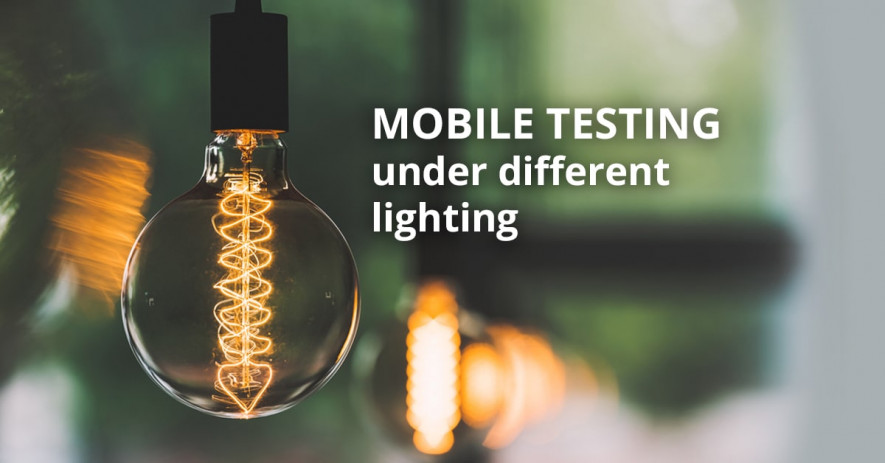- QATestLab Blog >
- Mobile Testing >
- Why to Perform Mobile Testing Under Different Lighting?
Why to Perform Mobile Testing Under Different Lighting?

Note: the article was updated in December 2018.
Nowadays, wherever you go you always take your smartphone with you. That implies using the device indoor and outdoor, in the daylight and twilight, under an incandescent lamp, or other illumination.
But, as far as screens reflect surrounding light, under certain conditions it is hard to see an explicit picture on your smartphone. Of course, light sensors adjust the screen to the environment, but sometimes it is not enough.
In order to ensure your application is properly displayed under any condition, you should test it under different lighting.
Common issues
You may face some troubles watching the pictures under the bright sun on your smartphone. Sometimes, it is even hard to take photos outdoors because you don’t clearly see what exactly will be shot.
When you use the application under faint light or no illumination at all, you can encounter other kinds of problems. Too acid colors can damage your eyes and even provoke head pain.
Also, the picture on the screen can be distorted under particular angles so that it is even hard to distinguish separate elements.
During mobile application testing, all these circumstances should be reproduced to simulate real user experience. The expected result is that the application should be distinct and readable under any light of surrounding. User interface colors should be bright and contrast enough to be explicit even when the screen is faded. It is important that the background should not mix and or merge with the fonts.
In general, we suggest testing the application under:
- natural lightning
- artificial lighting
- bright sunshine
- faded lighting
- no lightning at all
Also, testing outdoor, you can go further and test the application with the sunglasses. It is important while testing to bear in mind that different screens render different colors and details.
Modern displays
TN
TN is a basic liquid crystal technology. TN displays are cheap and easy to manufacture, but, therefore the quality is not the best. Such screens distort the picture a lot under wide angles. Moreover, picture contrast is low and the colors are faint. Today, liquid crystal technology has greatly stepped forward, and the more advanced IPS has replaced the TN standard.
IPS
The main feature of IPS matrix is its ability to convey natural colors. This is the reason for the big popularity of this screen among modern smartphones. IPS display has wide angles of view and high brightness of the picture. Among the disadvantages of this technology, there is the black color. It is not deep enough and, therefore, the contrast of the picture on the screen concedes other technologies, e.g., AMOLED displays.
AMOLED
AMOLED technology is based on light-emitting diodes which illuminate separate pixels. The main advantage of AMOLED matrix is its deep black color. Though the first AMOLED displays had the inaccurate color rendering and some colors were too bright, today it has improved a lot. Deep black color contributes high contrast and sharp picture.
Super AMOLED
Super AMOLED is a step forward in AMOLED technology. Its distinguishing feature is the touch response layer integrated into the display itself, rather than on top of it. The advantages of such a screen are high contrast and brightness, deep colors, and wide angles of view.
Retina
Retina display is an Apple-branded high-quality IPS display. It incorporates IPS matrix advantages with high-resolution and pixel density. Therefore, the picture on such a screen is sharp and has wide angles of view. Color reproduction is natural and accurate.
Screens under bright lightning
Today, when you use your IPS or AMOLED mobile device in the environments with a lot of ambient light, you will probably notice no difference. But still, in some cases, e.g., watching videos or using the dark theme, the lack of deep black on IPS screen can be notable.
Despite that IPS and other liquid crystal screens have higher brightness lever, AMOLED outclasses IPS in the bright sun as well. Moreover, Super AMOLED proved to handle sunlight even better than standard AMOLED display.
Testing an application under different lighting always consider these peculiarities of a device screen to give an adequate assessment of the software quality.
Learn more from QATestLab
Related Posts:
- Automation Testing for Mobile Apps: Why It’s Essential and Our Key Services
- How One Bug Can Wreck Your Reputation — And How QA Prevents It
- Testing on Real Devices — Just an Option or a Necessity?







No Comments Yet!
You can be the one to start a conversation.